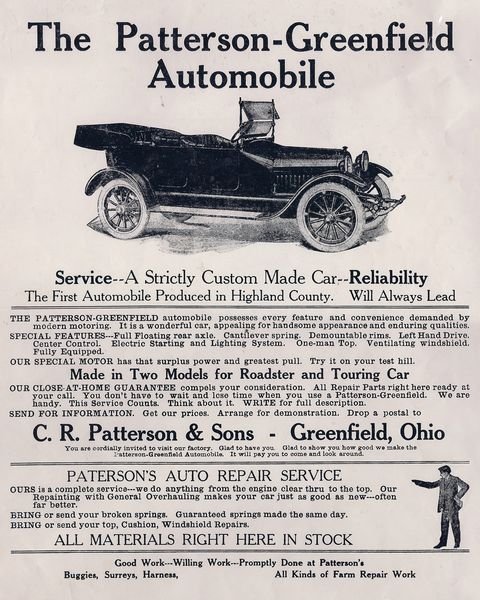C.R. Patterson & Sons - the First Black Owned Car Company
Original publication by the Petersen Automotive Museum on September 2, 2022.
Frederick Douglas Patterson, in front of his Patterson-Greenfield automobile. circa 1915
By the late 19th century, the United States had been fully ushered into a period of dramatic industrial and economic growth commonly known as the Gilded Age. Subsequently, at the turn of the century, the advent of purpose-built, single cylinder, self-propelled automobiles further revolutionized the coach and carriage manufacturing industries. Although emerging robber barons or “Captains of Industry”; dominated the economy through monopolies, smaller independent companies also saw opportunities to put themselves on the map, one such company, C.R. Patterson and Sons, would go on to become an early pioneer for independent car manufacturers and a trailblazer for black entrepreneurs.
Born into slavery on a Virginia plantation in 1833, Charles Richard Patterson or C.R. Patterson fled north to Greenfield, Ohio with his loved ones in the 1850s where he established himself as a blacksmith. Shortly after working as a foreman for the Dines and Simpson Carriage and Coach Makers Company, Patterson partnered with a white carriage manufacturer, J.P. Lowe, forming J.P. Lowe & Company in 1873. Charles Richard Patterson quickly became a high- profile and well-respected resident in Greenfield. Patterson, in addition to working as a foreman where he developed a reputation for overseeing the production of high-quality products, was also a trustee of the Greenfield African Methodist Episcopal Church in 1880, where he also taught Sunday school. When his son was denied admission to an all-white secondary school in the area, he filed a lawsuit against the local Board of Education, a case which he won. By 1888 the company had attracted 10 workers, a sizeable number for small businesses at the time. However, despite the company’s notable success, in January 1893, the overextension and failure of some of the country’s largest companies such as the Philadelphia and Reading Railroad Co. ignited a panic and ensuing economic crisis. Commonly known as the Panic of 1893, the depression lasted four years and saw stock prices plummet and unemployment skyrocket across the country reaching as high as 25 percent. Patterson, seeking to start his own company, used the opportunity to buy out Lowe’s shares and became[ the sole proprietor of the company, renaming it C.R. Patterson and Sons, an act virtually unheard of at the time for a Black man. Patterson ran a successful business producing 28 different horse-drawn carriage styles and approximately 500 horse-drawn carriages per year as well as employed an integrated workforce of 35-50 craftsmen.
Following his death in 1910, Charles’s son, Frederick Douglas Patterson inherited his father’s carriage business. In addition to graduating top of his class in high school and being the first black athlete to play football for Ohio State University, Frederick Douglas Patterson was also the vice president of the National Negro Business League. The organization, founded by Booker T. Washington in 1900, was designed to generate economic growth and autonomy within the Black community. Frederick, utilizing his entrepreneurial disposition, quickly recognized the potential and growing popularity of horseless carriages and produced the company’s first automobile in 1915. Following the production of the Patterson-Greenfield Automobile, he became the first and only Black owner and operator of an automobile Company. Frederick said of the Patterson- Greenfield Automobile: “It is not intended for a large car. It is designed to take the place originally held by the family surrey. It is a 5-passenger vehicle, ample and luxurious.” The Company offered several models of coupes and sedans including a state-of-the-art 4-cylinder 30 hp Continental “Red Devil” speedster. The company was well respected and saw considerable success but failed to keep up with Ford’s assembly line manufacturing capacity at the turn of the century. By the 1920s, the company shifted its efforts towards designing truck and bus chassis made by other manufacturers such as Ford and General Motors. The company was renamed Greenfield Bus Body Company following Frederick’s death In 1932 but, due to the crippling effects of the Great Depression, the independent auto manufacturer was ultimately forced to close production in 1939.
Sources:
https://www.automobiledrivingmuseum.org/charles-richard-patterson/
https://nmaahc.si.edu/explore/stories/only-african-american-automobile-company
https://arstechnica.com/cars/2021/03/the-life-and-times-of-c-r-patterson-sons-the-first-black-owned-us-automaker/
https://www.google.com/url?q=https://ohiohistorycentral.org/w/Panic_of_1893&sa=D&source=docs&ust=1658869258158160&usg=AOvVaw1fNArr_KV1m_p5JDFHaXvN








